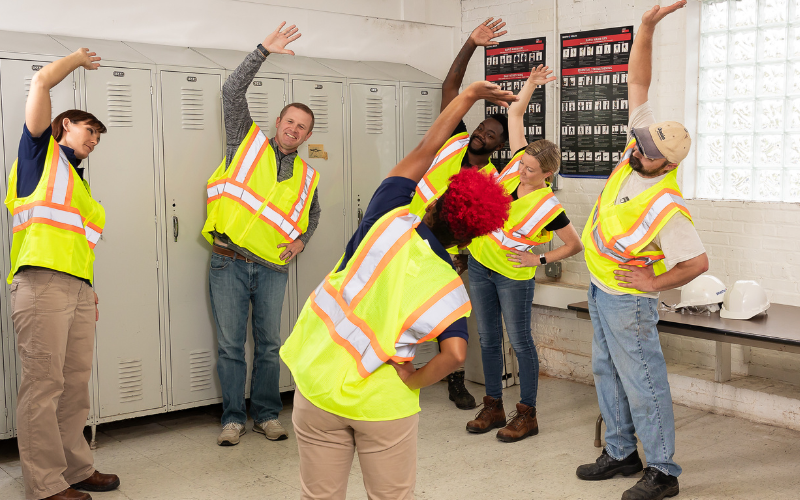Creating a healthier, safer, and more productive workplace doesn’t always require expensive equipment or large-scale changes. Sometimes, the key to meaningful improvement lies in awareness—specifically, ergonomic awareness.
At its core, an ergonomic awareness program helps workers and management understand how small adjustments in work habits, posture, tools, and communication can lead to big benefits in comfort, safety, and performance. But before jumping into charts, checklists, and training schedules, it's important to take a step back and look at the “why” behind ergonomics.

The Philosophy of Ergonomic Awareness
Ergonomics is the science of fitting a job to a person, not the other way around. This concept takes into account the physical setup of a job, but more importantly, it respects the worker, acknowledges that each task is unique, and highlights the connection between wellness and productivity.
When a company decides to start an ergonomic awareness program, it’s making a statement: We care about how our employees feel at work. That message builds trust. It creates a workplace culture that prioritizes comfort, prevention, and communication over reaction and injury management.
In workplaces without an ergonomic program in place, discomfort and potential hazards are more likely to go unnoticed or unspoken until they turn into injuries. This reactive approach leads to lost productivity, increased workers’ compensation claims, and employee dissatisfaction. By contrast, a proactive, culture-driven ergonomic awareness program shifts the conversation toward prevention, collaboration, and shared responsibility.
The Benefits of Ergonomic Awareness
Introducing ergonomic awareness is a step in the right direction for any business. The benefits go beyond what most assume when they hear ergonomics, like posture correction or better chairs. A strong ergonomic culture can lead to:
- Improved Worker Wellness
When workers understand how to reduce strain and discomfort during daily tasks, they feel better both physically and mentally. This leads to happier employees, increased productivity, and less fatigue.
- Reduced Injuries
Musculoskeletal disorders (MSDs), like back pain or carpal tunnel syndrome, are among the most common workplace injuries. Many of these are preventable with basic ergonomic adjustments and prevention. When employees are aware of risks and empowered to make changes, injury rates drop significantly.
- Better Communication
Ergonomic programs improve communication between workers and management. When employees are encouraged to share discomforts or suggest workstation improvements, it creates a workplace where feedback is welcomed and problems are solved early, before they develop into injuries.
- Higher Productivity
Comfortable employees are more focused, efficient, and able to sustain their performance throughout the day. Ergonomic practices identify injuries before they happen, reduce discomfort-related distractions, and improve the return-to-work process. You may also find increased efficiency with actions like reducing reach distances and improving working heights.
- Increased Employee Satisfaction and Retention
A company that invests in ergonomics shows that they value their workforce and are ready to support them for the long term. That leads to lower turnover rates and keeps your knowledgeable employees with you longer.

Practical Steps to Creating an Ergonomic Awareness Program
So how does a workplace with no current ergonomic strategy go from nothing to something sustainable and successful? Below is a clear step-by-step guide to help you start from the ground up.
Step 1: Assess Your Current State
Before jumping into solutions, understand where your workplace stands. Ask questions like:
- Do employees report discomfort or injuries related to posture or repetitive motion?
- Are there any current programs addressing ergonomics or physical wellness?
- Do managers and team members know how to spot ergonomic issues?
A basic survey can be a good place to start. Include questions about work tasks, comfort levels, and perceived risks. You can also gather data from injury reports or workers’ compensation records.
Resource for industrial work environments: Use this industrial safety checklist, which includes a section on ergonomics, to review your workplace.
Step 2: Choose the Right Ergonomic Program Type
Ergonomic awareness can take many forms depending on your budget, industry, and workforce. Some options companies may look at are:
- Basic Awareness Training: Short sessions or online modules that teach employees the basics of body mechanics, workstation setup, and safe movement
- Ergonomic Screenings: One-on-one assessments of workstations with individualized suggestions
- Stretching and Microbreak Programs: Guided routines that help prevent repetitive stress injuries, especially in physically demanding or sedentary jobs
- Advanced Ergonomic Evaluations: Detailed job analyses and equipment recommendations from certified ergonomists
If budget is a concern, start small. Even a short awareness campaign with posters and emails can kick-start the process. However, the cost savings from preventing injuries can be massive compared to the costs of any ergonomic program. Keeping employees safer is always a cost-saving solution.
Resource for industrial environments: Download our Sample Industrial Ergonomics Assessment to see what a thorough assessment looks like and how it can benefit your workplace.

Step 3: Engage Management First
For an ergonomic program to succeed, it needs top-down support. This means educating leadership about:
- The return on investment of reduced injuries and absenteeism
- The impact on employee satisfaction and morale
- The legal and safety benefits of a proactive program
Once managers are on board, they can help model ergonomic behavior. From adjusting their own workstations to encouraging stretch breaks during meetings, small inclusions of ergonomics can showcase their huge benefits. Their involvement sends a strong message that ergonomics is part of the company culture, not just a one-time training.
Step 4: Train and Empower Employees
Start with basic training sessions. They can even be highlights at the start of a shift meeting or spotlight in an all-hands. You should cover:
- What ergonomics is
- How repetitive motions, heavy forces or awkward postures can lead to injury
- How to adjust workstations or tools for better comfort
- How to recognize and report discomfort early
Encourage employees to take ownership of their workspaces. Provide checklists or self-guided assessments for adjusting workstations, equipment, or tools.
Resource for office workstations: Share our desk setup guide with your team! Find neutral posture when sitting and standing.
When possible, involve employees in conversations about the direction of your ergonomic program. Feedback from workers can highlight specific pain points and create more buy-in.
Step 5: Create Easy Access to Resources
Awareness is only valuable if employees can act on it. Make sure there are clear and simple paths for reporting ergonomic concerns and requesting equipment adjustments, ergonomic tools, or assessments.
Provide visual guides for workstation setup, quick stretch routines, or reminders about proper lifting techniques. These can be posted in break rooms, near workstations, or included in onboarding packets for new hires.
Some workplaces benefit from having an “ergonomic champion”, a designated team member trained to support coworkers, answer questions, and keep the program moving forward.

Step 6: Measure Progress and Adjust
Ergonomic awareness isn’t a one-time event, it’s an ongoing effort. Regularly evaluate the program’s effectiveness by:
- Tracking injury reports and discomfort complaints
- Sending follow-up surveys to employees
- Reviewing participation in training or stretching routines
Use this information to improve or expand the program. Maybe a department needs more in-depth training, or maybe a common piece of equipment is causing issues across teams.
Also, celebrate wins. Share when injury rates go down or survey results improve. Recognizing these milestones reinforces the value of the program.
Step 7: Plan for the Future
Once the basics are in place, think about how to grow the program. Some long-term goals might include:
- Implementing ergonomic awareness training and assessments for new hires and job tasks
- Offering adjustable workstations and tools
- Creating a rotating “stretch leader” schedule to build routine
- Partnering with trained health care professionals or ergonomists for annual assessments
- Developing a return-to-work program for employees
As technology changes and your workforce grows, your ergonomic strategy should adapt too. Staying flexible and open to new ideas is part of building a truly sustainable program.
Ergonomics Programs Improve Worker Experience and Business Outcomes
Building an ergonomic awareness program starts with the idea of preventing injury. But with good planning and commitment, it can be about creating a culture of care, communication, and continuous improvement. By starting with the philosophical idea that every employee deserves a comfortable and safe workplace, and following through with practical, step-by-step implementation, any organization can build a program that pays off in health, morale, and productivity.
Whether you’re in an office, a warehouse, or on the factory floor, ergonomics should be part of the daily conversation. And with the right mindset and a few practical tools, creating that conversation is easier—and more impactful—than you might think.
Not sure where to start? Get an ergonomics consultation!
We offer ergonomics services and consulting for projects of all sizes. These services are designed to identify and address ergonomic issues and risks in both office and industrial workplaces.
Discuss your ergonomics needs with our experts!